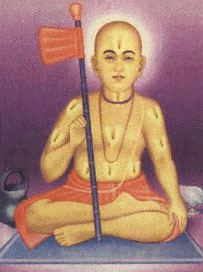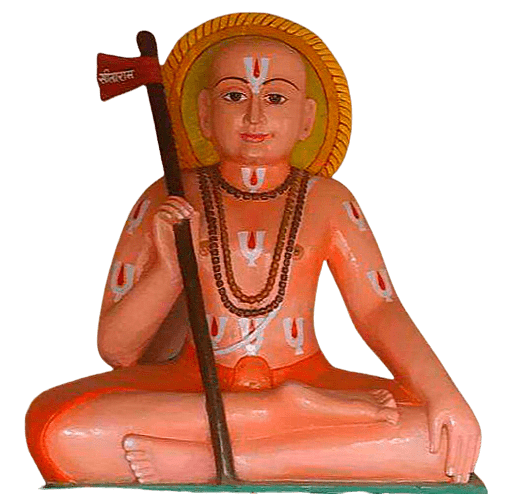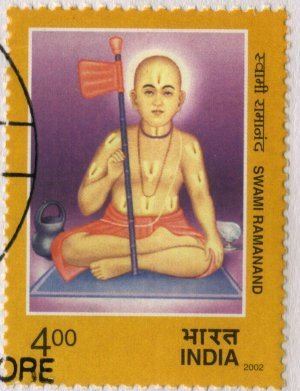Name Sant Ramananda | ||
 | ||
Notable disciple(s) Known for Ramanandi Sampradaya,Guru of major poet-sants,a pioneer of Bhakti movement in north India, Social reformer Born 1400 (age 76), Prayagraj Died 1476 (aged 76), Varanasi Similar Surdas, Namdev, Ravidas | ||
Ramananda (IAST: Rāmānanda) was a 14th-century Vaishnava devotional poet sant, in the Ganga river region of Northern India. The Hindu tradition recognizes him as the founder of the Ramanandi Sampradaya, the largest monastic Hindu renunciant community in modern times.
Contents
- Sant Ramananda biography in Hindi
- Vaishnava Event Sri Ramananda Raya
- Biography
- Literary works
- Philosophy
- Legacy
- Twelve disciples of Jagadguru Ramanandacharya
- Largest ascetic community in India Ramanandi Sampraday
- Social reforms
- Swami Ramanand poem
- References

Born in a Brahmin family, Ramananda for the most part of his life lived in the holy city of Varanasi. His year of birth or death are uncertain, but historical evidence suggests he was one of the earliest sants and a pioneering figure of the Bhakti movement as it rapidly grew in north India, sometime between the 14th and mid 15th century during its Islamic rule period. Tradition asserts that Ramananda developed his philosophy and devotional themes inspired by the south Indian Vedanta philosopher Ramanuja, however evidence also suggests that Ramananda was influenced by Nathpanthi ascetics of the Yoga school of Hindu philosophy.
An early social reformer, Ramananda accepted disciples without discriminating anyone by gender, class, caste or religion (he accepted Muslims). Traditional scholarship holds that his disciples included later Bhakti movement poet-sants such as Kabir, Ravidas, Bhagat Pipa and others, however some postmodern scholars have questioned some of this spiritual lineage while others have supported this lineage with historical evidence. His ideas also influenced the founding of Sikhism in 15th century, and his verse and he are mentioned in the Sikh scripture Adi Granth.

Ramananda was known for composing his works and discussing spiritual themes in vernacular Hindi, stating that this makes knowledge accessible to the masses.
Sant Ramananda biography in Hindi
Vaishnava Event - Sri Ramananda Raya
Biography

Little is known with certainty about the life of Ramananda, including year of birth and death, as well as the place of birth. His biography has been derived from mentions of him in secondary literature and inconsistent hagiographies.
The most accepted version holds that Ramananda was born in a Brahmin family, about mid 14th-century, and died about mid 15th-century. There are two competing theories for his place of birth. One version, based on Agastya-samhita, states that he was born in Prayag, a place now known as Allahabad, to Sushila and Punyasadan. Another version states that he was born in south India, and settled in the holy city of Varanasi to launch the Bhakti movement already established in southern regions of India.
According to the medieval era Bhaktamala text by Nabhadas, Ramananda studied under Raghavananda, a guru (teacher) in Vedanta-based Vatakalai (northern, Rama-avatar) school of Vaishnavism. Other scholars state that Ramananda's education started in Adi Shankara's Advaita Vedanta school, before he met Raghavananda and began his studies in Ramanuja's Vishishtadvaita Vedanta school.
Literary works
Ramananda is credited as the author of many devotional poems, but like most Bhakti movement poets, whether he actually was the author of these poems is unclear. Two treatises in Hindi, Gyan-lila and Yog-cintamani are also attributed to Ramanand, as are the Sanskrit works Vaisnava Mata Bhajabhaskara and Ramarcana paddhati. However, poems found in the original and well-preserved manuscripts of Sikhism and handwritten Nagari-pracarini Sabha are considered authentic and highlight the Nirguna (attributeless god) stream of thought in Ramananda.
Philosophy
Ramananda developed his philosophy and devotional themes inspired by the south Indian Vedanta philosopher Ramanuja, however evidence also suggests that Ramananda was influenced by Nathpanthi ascetics of the Yoga school of Hindu philosophy.
Antonio Rigopoulos states Ramananda's teachings were "an attempt towards a synthesis between Advaita Vedanta and Vaishnava bhakti". He adds that the same link can be found in the 15th-century text of Adhyatma Ramayana, but there is no historical proof that Ramananda's teachings inspired that text.
Shastri has proposed the theory that Ramananda's complex theological schooling in two distinct Hindu philosophies explains why he accepted both Saguna Brahman and Nirguna Brahman, or god with attributes and god without attributes respectively. Shastri suggests his theory offers an explanation why Ramananda's disciples co-developed saguna and nirguna as the two parallel currents in the Bhakti movement. However, this theory lacks historical evidence and has not gained wide acceptance by scholars.
The Ramananda literature that is considered authentic, states Enzo Turbiani, suggest a milestone development in metaphysical principles of the Bhakti movement. Ramananda asserts that austerity and penances through asceticism are meaningless, if an individual does not realize Hari (Vishnu) as their inner self. He criticizes fasting and rituals, stating that the mechanics are not important, and that these are useless if the individual does not take the opportunity to reflect and introspect on the nature of Brahman (supreme being). Ramananda states that rote reading of a sacred text is of no benefit, if the person fails to understand what the text is trying to communicate.
Legacy
Ramananda is often honored as the founder of Sant-parampara (literally, the tradition of bhakti sants) in north India. His efforts, in a time when Ganges river plains of north India was under Islamic rule, helped revive and refocus Hindus to a personalized, direct devotional form of Rama worship, his liberalism and focus on the devotee's commitment rather than birth or gender set a precedent that attracted people to spirituality from various walks of life, and his use of vernacular language instead of Sanskrit for spiritual ideas made sharing and reflection easier for the masses.
Twelve disciples of Jagadguru Ramanandacharya
Twelve influential disciples of Ramananda included 10 men and 2 women poet-sants. According to Bhaktamal, these were:
Men scholars:
- Anantananda
- Sursurananda
- Sukhanand
- Naraharidāsa
- Bhavanand
- Bhagat Pipa
- Kabir
- Sen
- Dhanna
- Ravidas
Women scholars:
- Sursuri
- Padyawati
Postmodern scholars have questioned some of the above guru-disciple lineage while others have supported this lineage with historical evidence.
Largest ascetic community in India: Ramanandi Sampraday
Ramananda is the founder of the eponymous Ramanandi Sampraday (Shri Ramavat or Shri Sampraday). This is the largest ascetic community in India, and their members are known as Ramanandis, Vairagis or Bairagis. They are known for their self-imposed highly disciplined, austere, structured and simple lifestyle. Richard Burghart acknowledges that Ramananda is revered as the founder in the Ramanandi Sampraday's tradition, but adds that historical evidence about its origin is meager and India's largest monastic community may have gathered strength a few centuries after Ramananda's death.
Social reforms
Ramananda was an influential social reformer of Northern India. His championed the pursuit of knowledge and direct devotional spirituality, and did not discriminate based on birth family, gender or religion.
Don’t ask a sadhu his caste, ask him about knowledge instead.
Swami Ramanand poem
One poem of Swami Ramanand poem, originally written in Hindi, is a response to an invitation to go to a temple, and the answer states there is no need to visit a temple because God is within a person, all pervasive in everything and everyone.
